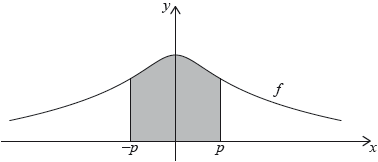| Date | May 2022 | Marks available | 5 | Reference code | 22M.2.AHL.TZ2.11 |
| Level | Additional Higher Level | Paper | Paper 2 | Time zone | Time zone 2 |
| Command term | Find | Question number | 11 | Adapted from | N/A |
Question
Two airplanes, and , have position vectors with respect to an origin given respectively by
where represents the time in minutes and .
Entries in each column vector give the displacement east of , the displacement north of and the distance above sea level, all measured in kilometres.
The two airplanes’ lines of flight cross at point .
Find the three-figure bearing on which airplane is travelling.
Show that airplane travels at a greater speed than airplane .
Find the acute angle between the two airplanes’ lines of flight. Give your answer in degrees.
Find the coordinates of .
Determine the length of time between the first airplane arriving at and the second airplane arriving at .
Let represent the distance between airplane and airplane for .
Find the minimum value of .
Markscheme
let be the required angle (bearing)
EITHER
(M1)
Note: Award M1 for a labelled sketch.
OR
(M1)
THEN
A1
Note: Do not accept or or .
[2 marks]
METHOD 1
let be the speed of and let be the speed of
attempts to find the speed of one of or (M1)
or
Note: Award M0 for and .
(km min-1) and (km min-1) A1
so travels at a greater speed than AG
METHOD 2
attempts to use
and (M1)
for example:
and
and
and A1
so travels at a greater speed than AG
[2 marks]
attempts to use the angle between two direction vectors formula (M1)
(A1)
or
attempts to find the acute angle using their value of (M1)
A1
[4 marks]
for example, sets and forms at least two equations (M1)
Note: Award M0 for equations involving only.
EITHER
attempts to solve the system of equations for one of or (M1)
or A1
OR
attempts to solve the system of equations for and (M1)
or A1
THEN
substitutes their or value into the corresponding or (M1)
A1
Note: Accept . Accept km east of , km north of and km above sea level.
[5 marks]
attempts to find the value of (M1)
minutes ( seconds) A1
[2 marks]
EITHER
attempts to find (M1)
attempts to find their (M1)
A1
OR
attempts to find (M1)
attempts to find their (M1)
A1
Note: Award M0M0A0 for expressions using two different time parameters.
THEN
either attempts to find the local minimum point of or attempts to find the value of such that (or equivalent) (M1)
minimum value of is (km) A1
Note: Award M0 for attempts at the shortest distance between two lines.
[5 marks]
Examiners report
General comment about this question: many candidates were not exposed to this setting of vectors question and were rather lost.
Part (a) Probably the least answered question on the whole paper. Many candidates left it blank, others tried using 3D vectors. Out of those who calculated the angle correctly, only a small percentage were able to provide the correct true bearing as a 3-digit figure.
Part (b) Well done by many candidates who used the direction vectors to calculate and compare the speeds. A number of candidates tried to use the average rate of change but mostly unsuccessfully.
Part (c) Most candidates used the correct vectors and the formula to obtain the obtuse angle. Then only some read the question properly to give the acute angle in degrees, as requested.
Part (d) Well done by many candidates who used two different parameters. They were able to solve and obtain two values for time, the difference in minutes and the correct point of intersection. A number of candidates only had one parameter, thus scoring no marks in part (d) (i). The frequent error in part (d)(ii) was providing incorrect units.
Part (e) Many correct answers were seen with an efficient way of setting the question and using their GDC to obtain the answer, graphically or numerically. Some gave time only instead of actually giving the minimal distance. A number of candidates tried to find the distance between two skew lines ignoring the fact that the lines intersect.


